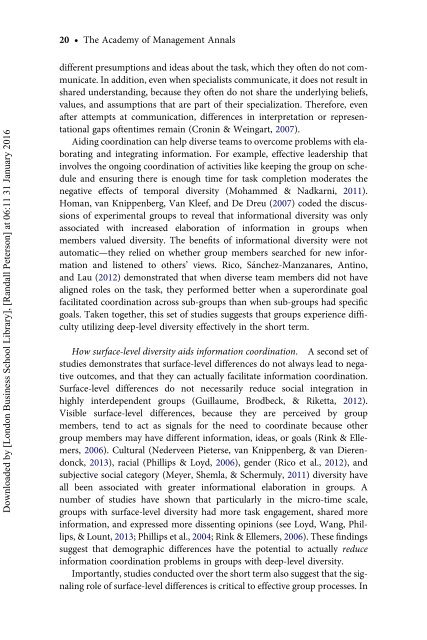A Dynamic Perspective on Diverse Teams: Moving From The Dual Process Model to A Dynamic Coordination-Based Model of Diverse Team Performance - Kannan Srikanth, Sarah Harvey & Randall Peterson
The existing literature on diverse teams suggests that diversity is both helpful to teams in making more information available and encouraging creativity and damaging to teams in reducing cohesion and information sharing. Thus the extant literature suggests that diversity within teams is a double-edged sword that leads to both positive and negative effects simultaneously.
The existing literature on diverse teams suggests that diversity is both helpful to teams in making more information available and encouraging creativity and
damaging to teams in reducing cohesion and information sharing. Thus the
extant literature suggests that diversity within teams is a double-edged sword
that leads to both positive and negative effects simultaneously.
Create successful ePaper yourself
Turn your PDF publications into a flip-book with our unique Google optimized e-Paper software.
20 † <strong>The</strong> Academy <strong>of</strong> Management Annals<br />
Downloaded by [L<strong>on</strong>d<strong>on</strong> Business School Library], [<strong>Randall</strong> Peters<strong>on</strong>] at 06:11 31 January 2016<br />
different presumpti<strong>on</strong>s and ideas about the task, which they <strong>of</strong>ten do not communicate.<br />
In additi<strong>on</strong>, even when specialists communicate, it does not result in<br />
shared understanding, because they <strong>of</strong>ten do not share the underlying beliefs,<br />
values, and assumpti<strong>on</strong>s that are part <strong>of</strong> their specializati<strong>on</strong>. <strong>The</strong>refore, even<br />
after attempts at communicati<strong>on</strong>, differences in interpretati<strong>on</strong> or representati<strong>on</strong>al<br />
gaps <strong>of</strong>tentimes remain (Cr<strong>on</strong>in & Weingart, 2007).<br />
Aiding coordinati<strong>on</strong> can help diverse teams <strong>to</strong> overcome problems with elaborating<br />
and integrating informati<strong>on</strong>. For example, effective leadership that<br />
involves the <strong>on</strong>going coordinati<strong>on</strong> <strong>of</strong> activities like keeping the group <strong>on</strong> schedule<br />
and ensuring there is enough time for task completi<strong>on</strong> moderates the<br />
negative effects <strong>of</strong> temporal diversity (Mohammed & Nadkarni, 2011).<br />
Homan, van Knippenberg, Van Kleef, and De Dreu (2007) coded the discussi<strong>on</strong>s<br />
<strong>of</strong> experimental groups <strong>to</strong> reveal that informati<strong>on</strong>al diversity was <strong>on</strong>ly<br />
associated with increased elaborati<strong>on</strong> <strong>of</strong> informati<strong>on</strong> in groups when<br />
members valued diversity. <strong>The</strong> benefits <strong>of</strong> informati<strong>on</strong>al diversity were not<br />
au<strong>to</strong>matic—they relied <strong>on</strong> whether group members searched for new informati<strong>on</strong><br />
and listened <strong>to</strong> others’ views. Rico, Sánchez-Manzanares, Antino,<br />
and Lau (2012) dem<strong>on</strong>strated that when diverse team members did not have<br />
aligned roles <strong>on</strong> the task, they performed better when a superordinate goal<br />
facilitated coordinati<strong>on</strong> across sub-groups than when sub-groups had specific<br />
goals. Taken <strong>to</strong>gether, this set <strong>of</strong> studies suggests that groups experience difficulty<br />
utilizing deep-level diversity effectively in the short term.<br />
How surface-level diversity aids informati<strong>on</strong> coordinati<strong>on</strong>. A sec<strong>on</strong>d set <strong>of</strong><br />
studies dem<strong>on</strong>strates that surface-level differences do not always lead <strong>to</strong> negative<br />
outcomes, and that they can actually facilitate informati<strong>on</strong> coordinati<strong>on</strong>.<br />
Surface-level differences do not necessarily reduce social integrati<strong>on</strong> in<br />
highly interdependent groups (Guillaume, Brodbeck, & Riketta, 2012).<br />
Visible surface-level differences, because they are perceived by group<br />
members, tend <strong>to</strong> act as signals for the need <strong>to</strong> coordinate because other<br />
group members may have different informati<strong>on</strong>, ideas, or goals (Rink & Ellemers,<br />
2006). Cultural (Nederveen Pieterse, van Knippenberg, & van Dierend<strong>on</strong>ck,<br />
2013), racial (Phillips & Loyd, 2006), gender (Rico et al., 2012), and<br />
subjective social category (Meyer, Shemla, & Schermuly, 2011) diversity have<br />
all been associated with greater informati<strong>on</strong>al elaborati<strong>on</strong> in groups. A<br />
number <strong>of</strong> studies have shown that particularly in the micro-time scale,<br />
groups with surface-level diversity had more task engagement, shared more<br />
informati<strong>on</strong>, and expressed more dissenting opini<strong>on</strong>s (see Loyd, Wang, Phillips,<br />
& Lount, 2013; Phillips et al., 2004; Rink & Ellemers, 2006). <strong>The</strong>se findings<br />
suggest that demographic differences have the potential <strong>to</strong> actually reduce<br />
informati<strong>on</strong> coordinati<strong>on</strong> problems in groups with deep-level diversity.<br />
Importantly, studies c<strong>on</strong>ducted over the short term also suggest that the signaling<br />
role <strong>of</strong> surface-level differences is critical <strong>to</strong> effective group processes. In
















